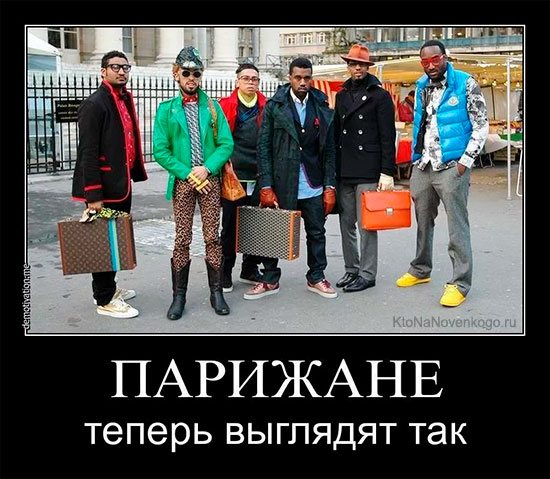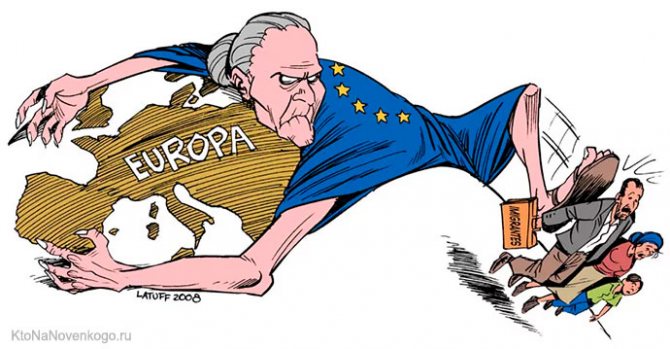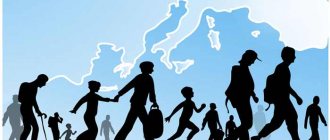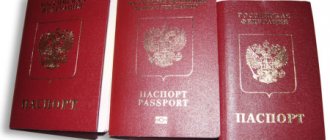January 19, 2021
Hello, dear readers of the KtoNaNovenkogo.ru blog. The modern world is characterized by high geographic mobility of people who migrate within states and move from one country to another.
In the latter case, we are talking about the interconnected processes of emigration and immigration.
Let's figure out who is called an immigrant and an emigrant, what is the difference between them and what makes people leave their homeland.
An emigrant is...
An emigrant (French emigre) is a person who moves from his country to another. The term is relevant for a person who has left his homeland.
The reasons why people become emigrants can be divided into two large groups:
- Voluntary - employment, education, reunification with relatives or with the historical homeland, marriage with a citizen of a foreign country.
- Forced - wars, armed conflicts, hunger, disease, poverty, persecution for ethnic, political, religious, cultural reasons.
Only those persons who left the country for a long period of time or permanently can be classified as emigrants.
Tourists, workers who went abroad under a contract, people who went abroad on a business visit do not fall into this category.

Who are emigrants and immigrants?
It is difficult for some people to grasp the difference in the meanings of these terms due to the fact that the words are very consonant. But there are still differences:
- An emigrant is a person who leaves his homeland and moves to a foreign country.
- An immigrant is a foreigner who moves to another country for permanent or temporary residence.
In fact, everything is simple and complex at the same time, because the meaning depends on the point of view. Let's consider an example: a person decided to move for permanent residence to another state. This means that he will be an emigrant for his country, since he left its borders. And for the country in which he settled, he will be an immigrant. It is easier to understand and remember the difference if we draw an analogy with the “export” and “import” of goods: the mechanism is the same, only in this case people move.
See also: What citizenship is easiest for Russians to obtain?
An immigrant is...
An immigrant (lat. immigrans - moving in) is a person who arrives in any state for a long time or for permanent residence. In relation to the indigenous inhabitants of the new country, he acts as a stranger.
For such people, when moving to a new place, it takes time to adapt (what is it?) due to linguistic, cultural, ethnic and mental differences.

Subsequently, immigrants assimilate with the local population. This means that previously acquired social traits are being replaced by those borrowed from another nation or people.
Migration - concept
Initially, the concept of “migration” was used in the field of ornithology, but later it was designated as the movement of people that result from the latter changing their place of residence. Migrants are people who leave their usual location and go to a new one, or are simply constantly on the move.
This word comes from migrare (Latin word). The words “emigration” and “immigration” are derived from it. The prefix ex in the first case is translated as “outside, outside.” In the second case, the prefix im is “inside, in.”

An emigrant is a person (or even a family) who independently decided to move. People who leave the country forcibly or are deported are not emigrants.
The most famous Russian emigrants
Among the most famous Russian emigrants is the son of Peter I, Alexei, who fled from his father’s persecution first to Austria and then to Italy. The forced return of the king's obstinate son to his homeland led to his imminent death.
The forced emigrant was one of the leaders of the revolutionary camp of the social movement, A. Herzen, who left the tsarist regime for London. Here he was active, publishing the opposition newspaper Kolokol.
Foggy Albion has become a favorite place for other Russian emigrants. V. Rezun (Suvorov), famous for his books “Icebreaker” and “Day-M”, the famous restaurateur M. Zelman, and politician B. Berezovsky moved here at different times.
During Soviet times, emigrants actively left for the United States. The poet I. Brodsky, aircraft designer I. Sikorsky, and writers A. Solzhenitsyn and S. Dovlatov followed this path.

Mathematician S. Kovalevskaya and abstract artist V. Kondinsky found a new refuge in Germany. The poet K. Balmont and the writer I. Bunin settled in Paris. For some time, the poetess M. Tsvetaeva also lived in the French capital.
Classification of migration movement[ | ]
Different types of migration include:
- external and internal
- seasonal migration of tourists and agricultural workers;
- rural-urban migration occurring in developing countries during the process of industrialization (urbanization);
- migration from cities to rural areas, more common in developed countries (ruralization);
- nomadism and pilgrimage
- temporary and long-term
- pendulum
- border or transit
- illegal
Classification by shape:
- socially organized
- disorganized
Classification by reasons:
- economic
- social
- cultural
- political
- military
Classification by stages:
- making decisions
- territorial movement
- adaptation
What are the benefits and dangers of immigrants?
There are many examples in history when immigrants had a direct impact on the development of the state. Many of the US civilizational achievements would not have been possible without immigrants, including:
- Google creator S. Brin;
- one of the founders of the popular WhatsApp messenger Ya.Kum;
- scientist V. Zvorykin, who created television;
- PayPal payment system developer M. Levchin;
- founder of the Yahoo search engine D. Yang;
- one of the founders of the national park system D. Muir and many others.
Contrary to existing prejudices, immigrants do not contribute to a decline in living standards and an increase in unemployment.
Thus, in Israel, from 1989 to 1997, the number of working-age population increased by 15% due to immigrants from the former USSR. However, the unemployment rate (what is this?) and the incomes of citizens remained at least at the same level.
Immigrants in many countries are involved in the formation of ethnic entrepreneurship. In Western European countries, the Chinese specialize in small retail, immigrants from Eastern Europe specialize in food, and the Vietnamese sell flowers.
Visitors contribute to the welfare of the state by paying taxes. For example, in Germany, from 1990 to 2010, each immigrant paid 3.3 thousand euros more in taxes than he received social assistance from the state.

In countries with little natural growth, it is foreigners who compensate for the lack of working-age population.
According to forecasts, by 2050 in EU countries there will be two working people per citizen of retirement age. This means that the UK will need up to 5 million workers, and Germany 6-7 million.
On the other hand, uncontrolled flows of immigrants can provoke rampant crime, the spread of infectious diseases and the emergence of interethnic conflicts.
What is the difference between emigration and immigration?
In the case of emigration, citizens travel beyond the borders of the state, and in immigration, foreigners enter the country. The same person can be both an immigrant and an emigrant (depending on the border from which you look at him).
What is emigration?
The term “emigration” comes from the Latin word emigro (“to move out”) and means the relocation of people to another country. When talking about emigration, they usually use the preposition “from”, for example: “several years ago I emigrated from Russia to Germany.”
Usually a person himself decides to emigrate, there may be several reasons:
- poverty, hunger, unemployment;
- war;
- religious, political discrimination;
- ecological problems;
- low level of medical care;
- desire to reunite with relatives;
- lack of opportunity to obtain a profession;
- difficulties in implementing scientific tasks;
- problems in the implementation of professional and creative plans.
Important: emigrants do not have to change their citizenship or obtain a new one. For example, dual citizenship is allowed for Russian citizens.
Where do people most often emigrate? Of course, where it will be easier to get to. If they want to move, people often choose a new place, guided by certain aspects - is it easy to get permission to enter the state, will it be possible to get a job there officially.
What is immigration?
The term “immigration” comes from the Latin word immigro (“I move in”) and means the entry into a country of citizens with the desire to settle in it. Typically, immigrants use the preposition “in” when talking about themselves: “five years ago I immigrated to Germany.”
Immigration can be caused by a number of reasons:
- attracting low-paid labor;
- attracting “fresh minds” for the development of science;
- favorable economic conditions;
- stability that characterizes developed countries;
- avoiding persecution for political, racial, religious reasons.
Scientific approaches to the study of migration[ | ]
- Demographic approach
Studies migration from the point of view of reproduction and conservation of human populations, their numbers, sex and age structure. The processes taking place in this area are closely related to the demographic security of the country (A. Sovi, A. Landry, F. Notestein, D. I. Valentey, A. Ya. Kvasha, B. S. Khorev, etc.).
- Economic approach
The most universal approach. Considers migration as one of the most important regulators of the working-age population, which stimulates healthy competition in the labor market. Most types of migration are caused by economic necessity and are to one degree or another connected with the labor market (A. Smith, T. Malthus, K. Marx, D. Keynes, etc.). Among the Russian specialists who studied migration within the framework of this approach are L. I. Abalkin, G. S. Vitkovskaya, Zh. A. Zayonchkovskaya, L. L. Rybakovsky, A. V. Topilin.
- Legal approach
Determines the legal status of different categories of migrants. Aimed at developing legal norms and legislative acts, regulating the fundamental rights of migrants (V. I. Mukomel, E. A. Pain, etc.).
- Sociological approach
Focuses on problems associated with the adaptation of migrants to new living conditions. Another understanding of the role of the sociological approach is revealed in the work of T. N. Yudina “Sociology of Migration”, which emphasizes the role of sociology as an integrative science and expresses the need to create an integral special sociological theory of migration.
- Historical approach
Research into the history of migration movements of a particular region using historical and demographic studies that describe migration in the context of the historical evolution of demographic processes (D.K. Shelestov, V.M. Kabuzan, V.A. Iontsev, etc.).
- Psychological approach
The main emphasis falls on the motivational nature of migration. Migration is considered as a way to satisfy a number of social needs, including the need for self-affirmation (V.I. Perevedentsev, T.I. Zaslavskaya, V.M. Moiseenko, etc.).
- Historical-biological approach
Mainly developed by Russian scientists L.N. Gumilyov and others. The main concept in Gumilyov’s approach is passionarity. Passionarity as a characteristic of behavior is activity manifested in the individual’s desire for a goal (often illusory). A passionary trait is a genetic trait that is inherited and, according to L. Gumilyov’s hypothesis, underlies the phenomenon of passionarity as a trait of the human constitution. Passionaries (carriers of this trait) are distinguished by particularly active migration behavior; their percentage in the ethnic group largely determines the migration movement of the entire ethnic group. For example, the second half of the 16th century in Russia was an era of high passionate energy of the Great Russians, the result of which was an unprecedented expansion to the east. Other examples: the beginning of the Great Migration, Arab conquests, Viking campaigns, and so on.
The historical approach developed by the Russian scientist A.V. Yurin identifies three main stages in the development of population migration in Europe from the Time of the Great Geographical Discoveries to the present.
- The first stage ended by the middle of the 20th century, when Europe was the main region of population outflow.
- The second period - the mid-1950s - the end of the 1990s - characterizes Europe as the world's largest center of mass uncontrolled recruitment of foreign labor into low-paid and low-prestige areas of activity.
- The third period, from the late 1990s to the present, is a period of active regulation and restriction of immigration to Europe, when preference is given to highly skilled labor.
A gravity model can be used to theoretically estimate migration volumes. The gravity model of migration is a theoretical model, similar to Newton's Law of Attraction, used in urban studies that is used to predict rates of migration between two regions[22]. Newton's law states: "Any two bodies attract each other with a force proportional to the product of their masses and inversely proportional to the square of the distance between them." The geographical interpretation of this law uses the replacement of the concepts of "body" and "mass" with the concepts of "regions" and "significance", where significance can be measured in units of population, gross product volume or other suitable quantity. The gravity model of migration is based on the idea that as the importance of regions increases, the movement of people between them increases, and with increasing distance, other things being equal, it decreases.
Consequences of migration[ | ]
Migration is a rather complex and controversial process. Having a number of advantages and positive results for the development of receiving and sending countries, it also leads to negative consequences. The more the country's population is involved in migration processes, the more acute its consequences. For example, migration helps to improve the material well-being of families, but at the same time, maintaining a family and raising children is made more difficult by the absence of one or both parents.[13]
In addition to political, demographic and economic consequences, large-scale migration can also have sanitary and epidemiological consequences.
Spread of infectious diseases and parasites[ | ]
After the collapse of the USSR, the increase in the number of refugees and labor migrants worsened the sanitary and hygienic situation in Russia. There was an increase in the incidence of polio, diphtheria and whooping cough. The increase in the incidence of diphtheria was accompanied by high mortality. Compared to 1987, the incidence of head lice in 1992 increased 5-6 times[14].
The unsatisfactory sanitary and epidemiological situation in a number of countries and regions of the Russian Federation, and the influx of migrants from these places, have maintained the trend of importation of infectious diseases and parasites. According to data[15], numerous cases of importation of malaria, intestinal helminths, ascariasis, diphyllobothriasis, etc. have been recorded. The largest number of cases was registered in Moscow, St. Petersburg, the Republic of Sakha (Yakutia), the Khanty-Mansiysk Autonomous Okrug, and the Krasnodar Territory. Moreover, in 1999-2002 in Moscow and a number of regions of the Russian Federation, the entire incidence of ascariasis, opisthorchiasis, diphyllobothriasis and trichocephalosis was formed due to imported cases.
Imported cases of trichuriasis were also detected in ~10% of workers, refugees and migrants from neighboring countries - Ukraine, Kazakhstan, Tajikistan, Azerbaijan, Uzbekistan, etc. ~7% of imported cases of trichuriasis.
The arrival of infested geohelmenites can create new foci of helminthiases on the territory of the Russian Federation.
According to data[16], an unfavorable epidemic situation regarding cholera existed in Kazakhstan, Uzbekistan, Turkmenistan and Tajikistan. In 2003, 533 cases of malaria were reported; imports were carried out from neighboring countries - Azerbaijan and Tajikistan (market traders, businessmen). At the same time, the organization of anti-epidemic measures can be difficult due to the fact that, for example, the duration of an air flight usually exceeds the incubation period of most diseases; in vehicles, the ventilation system can contribute to the spread of microorganisms among crowds of people, and at an early stage the clinical picture of many diseases is similar.
According to data[17], the prevalence of tuberculosis among migrants is significantly higher than among the indigenous population of the Russian Federation. This is explained by the fact that in the countries from which they came, tuberculosis is common (and in Uzbekistan, the proportion of cases of multidrug-resistant tuberculosis is 23% of all registered cases; and in the northwestern part of the country in 2010-2011 - up to 40 % of the number of new cases, and up to 75% of the number of previously identified cases[18]); Migrants often live in crowded conditions and have limited access to medical care (~22% practice self-medication; in Moscow, Volgograd, Tambov and Orenburg, 92% did not have health insurance). Considering the problem of financing the provision of medical care to migrants (including illegal and unemployed), the authors note that now the authorities in the Russian Federation consider it necessary to use the purchase of a voluntary health insurance policy to provide medical care that goes beyond emergency situations. But it does not cover the costs of treating diseases such as tuberculosis. In 2014, the 67th session of WHO adopted the Global Strategy to Counter Tuberculosis, which calls for facilitating migrants’ access to medical care regardless of their status (that is, in fact, from a budget generated from contributions from native taxpayers). However, this proposal caused a negative reaction from some government officials and politicians: “We consider this situation to be unfair to British taxpayers: temporary migrants do not provide financial support to the National Health Service, while permanent residents make contributions to the NHS throughout my working life in the UK." Ultimately, those medical institutions that treat tuberculosis patients (not included in the NHS system) began to receive reimbursement from the budget. The authors of the article proposed providing funding for the treatment of migrants in the Russian Federation through the interstate health insurance system, which would reduce the risk of the spread of infectious diseases in the Russian Federation and provide treatment for migrants. They argue that many migrants travel to the Russian Federation with the support of the authorities of their country of residence, and pay contributions there to maintain the (local) healthcare system. However, at the time of writing, such a mechanism was not available.
In St. Petersburg, strains of tuberculosis that cannot be treated have been identified. At the same time, according to British doctors, it turned out that the capabilities of fluorography to detect the disease are limited.[19] The trade in medical books, which is not stopped by the authorities, makes undergoing medical examinations a meaningless formality[20].
Since about 10% of migrants in the Russian Federation undergo regular medical examinations, this increases the risk of the spread of various diseases: HIV, measles, encephalitis, typhoid fever, smallpox[21].




